#zinat
Explore tagged Tumblr posts
Text
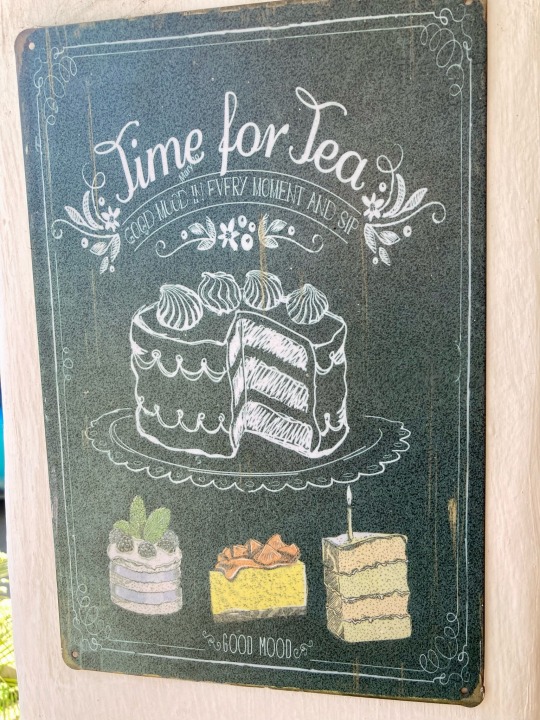
5 notes
·
View notes
Text
^ _ ^

2 notes
·
View notes
Note
Who is your favorite "unknown" mughal princess? By unknown I mean like women like Gauhar Ara begum, Nadira Banu begum, Zinat un nissa begum who were not documented so well.
*laughs*
Anon, that is a dangerous topic to get me started on. I have quite a few (and I'm omitting some of the big names that I also adore: Arjumand Banu, Mihrunissa, Hamida Banu Begum, etc.)
Khanzada Begum- Babur's sister, and--depending on which version you believe--either abandoned or straight up sold to Babur's enemy Shaybani Khan during Babur's escape. But! she wound up surviving both her marriage to the enemy, and returned to her now-victorious brother, subsequently marrying again under happier circumstances and becoming (according to some sources) the first Padishah Begum* of the empire.
*I feel like people often mistranslate this title as "Empress" or "Emperor's favorite wife," but it could just as often mean a beloved sister or daughter--basically, it was the most important woman in the royal family, and the one who effectively claimed the most power.
Gulbadan Begum - half-sister of Humayan, historian, and straight up nerd. Wrote her brother's biography, and delighted in telling embarassing anecdotes about him like any proper sibling. Loving aunt to Akbar; clever, independent, and fun.
Mah Chuchak Begum - widow of Humayan, ruler of Kabul (initially in the name of her son, apparently later just gave up on the pretense and ruled by herself). A hurdle in the path of the young Akbar's consolidation of the empire, she was unfortunately killed by her son-in-law. That said, years later, after her son had managed to piss off Akbar, her daughter Bakht-un-Nissa Begum wound up inheriting the governship of Kabul and apparently did a bang-up job of it.
Aram Banu Begum- Akbar's younger and favorite daughter, and explicitly a smart-aleck. Apparently Did Not get along with her half-brother Jahangir, to the point that one of Akbar's dying wishes was that the two get along. Never married, but seems to have been more a personal choice, rather than a strict decree against it. Seems to have been A Lot, in the best of ways.
Nadira Banu Begum- wife of Dara Shikoh, arguably in one of the happiest marriages of the dynasty. Dara never married anyone, and like her mother-in-law before her, Nadira joined her husband in exile and revolution. He apparently gave most of the paintings he loved to create to her, which is adorable; and did not survive her death by more than a few months.
Dilras Banu Begum - wife of Aurangazeb; apparently haughty and beautiful, and not a little terrifying. Interestingly, she was a devout Shia while Aurangazeb was a devout Sunni (to be fair, Shah Jahan and Mumtaz Mahal were also a very happy Sunni/Shia pair, but both Dilras and Aurangazeb were famously pious and much more religiously fixated than the prior generation). Died before her husband became Emperor, but her children would succeed him.
Zeb-un-nissa (&her siblings) - daughters of Aurangazeb, and talented poets, scholars, and artists. Particularly notable because while pop cultures has the later Mughal empire portrayed as either a joyless husk, or a decadent waste -- these women were clear contraindications to that generalization.
(I could go on, but these are the first few that come to mind!)
30 notes
·
View notes
Photo
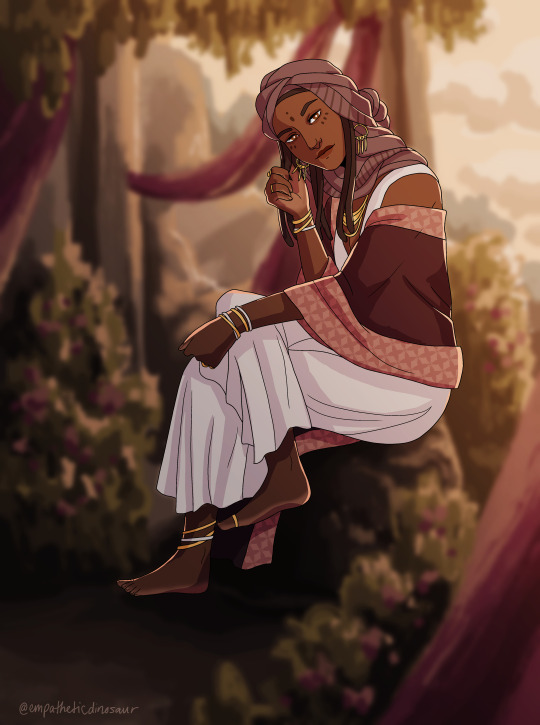
Zinat for @coinecai
#art fight#character portrait#illustration#artists on tumblr#illustrators on tumblr#art#digital art#clip studio#csp
9 notes
·
View notes
Text

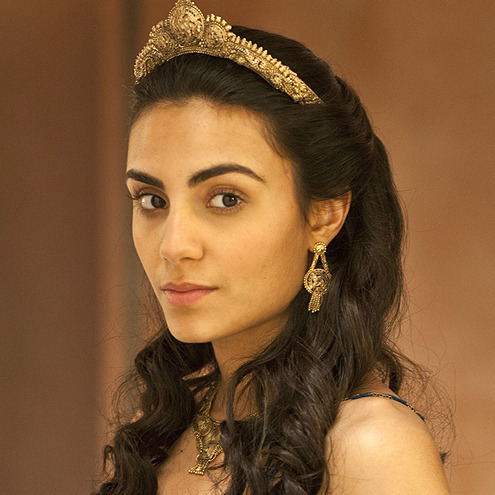



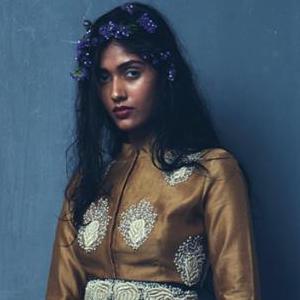
The Dancing Girls (Thick as Thieves)
Samira (Sara Ali Khan) ✦ Pari (Aiysha Hart) Zinat (Medalion Rahimi) ✦ Hurik (Alicia von Rittberg) Sevan (Özge Törer) ✦ Inaya (Varsha Gopal)
(character names are from my ongoing Queen's Thief fic, What We Are Allowed)
#it took me approximately a million years to choose faceclaims for all of them#what we are allowed#my ocs#queen's thief
24 notes
·
View notes
Text
“The most beloved of my AhlulBayt (as) to me and the best person I leave behind is `Ali ibn Abi Talib (as).”
— Prophet Muhammad (sa)
(Al-Amali)

-Zinat Daruwala
15 notes
·
View notes
Text
Journal d’Idrissa SAMBE de la semaine du 21 au 27 juillet 2023. YAKA - Aga biram

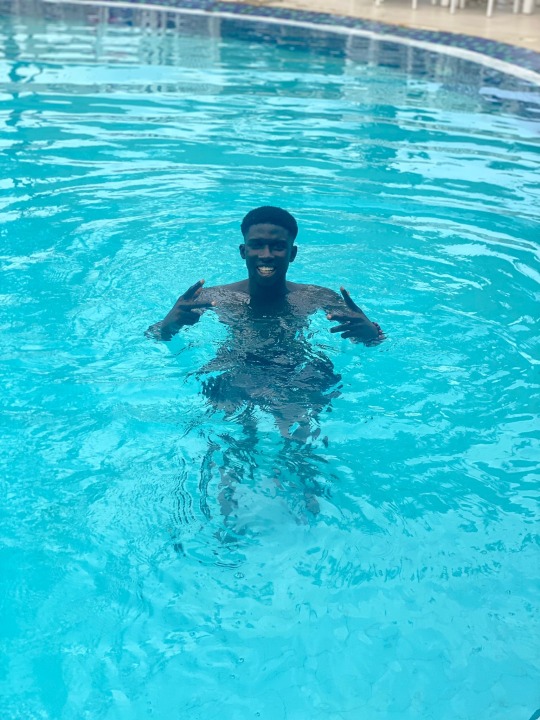
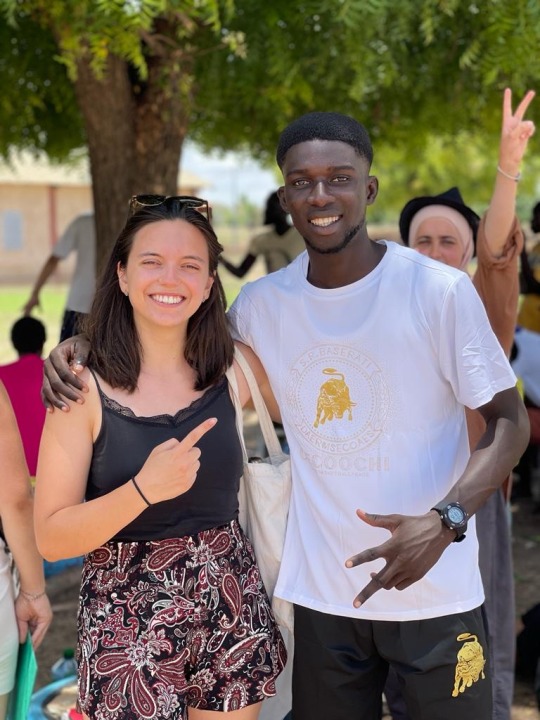
👉Vendredi 21 juillet 2023, c'était mon premier séjour à Aga Biram.
On est parti de Mbour à 9h pour rejoindre ce village.
On est arrivé vers 12h et les villageois nous ont accueillis avec joie et nous souhaitent la bienvenue.
Après avoir rencontré mon jumeau, il m'a amené dans leur maison et j'ai mangé avec eux.
À 15h30, nous nous sommes retrouvés à l'école pour établir notre planning de la semaine.
Je suis retourné chez mon jumeau, là où j'ai passé la nuit dans la chambre des invités avec son fils.
La journée était exceptionnelle.
👉Samedi 22 juillet 2023
Notre deuxième jour à Aga Birame. Je me suis réveillé à 8h, j'ai pris mon bain et mon petit déjeuner. Aussi, je suis sorti de la maison à 9h pour rejoindre les lauréats à l'école pour l'établissement des thèmes sur les deux forums (l'un à Aga Biram et l'autre à Dakar).
On a commencé vers 9h45 par un petit échauffement pour mieux se réveiller.
On a choisi comme thèmes l'environnement, l'amour, la solidarité, la beauté, l'éducation et l'émigration clandestine.
Après avoir pris une pause de 2h30 pour le repas, on est retourné à l'école pour commencer notre premier atelier dirigé par Zinat ayant comme thème la valorisation. On a abordé la thématique sous des formes de théâtre.
On a terminé la journée avec l'atelier de danse dirigé par Mame Mbaye Ndoye et Jean Mané.
La nuit, j'ai rendu visite à Léo qui habite à 500m du village, accompagné par Mame Tafsir et son jumeau.
Je me suis couché tôt pour les autres activités qui suivent.
On a passé une excellente journée où j'ai appris beaucoup de valeurs sur les lauréats.
👉Ce dimanche 23 juillet 2023, notre 3ème jour à Aga Birame.
Ce matin, vers 10h, on s'est regroupés dans la cour de l'école. On a discuté de nos différents thèmes du forum et échangé beaucoup d'idées. Ensuite, on a créé des petits groupes pour la visite des familles dans chaque quartier. On s'est amusés en dansant. L'activité s'est terminée vers 13h30. Je suis retourné à la maison pour mon repas. Ensuite, je me suis reposé pour être en forme pour l'activité qui suivait.
À 16h, on s'est rassemblés dans l'école avec le comité d'Aga Biram pour le projet de la boutique solidaire.
On a discuté du projet et j'ai posé des questions pour connaître leurs fournisseurs.
À 17h, on a fait le tour des familles par groupe sous des tirages.
Notre groupe a pris le quartier de Sassene qui se trouve près d'un kilomètre de l'école. On a pris le chemin et on a rencontré des paysans qui labouraient leurs champs.
On est retournés à l'école vers 18h et sommes allés aussi vers le quartier Soudiane pour visiter la boutique solidaire.
On a terminé les activités avec une petite séance d'animation avec les enfants du village.
Je suis retourné à la maison avec les habitants de mon quartier. La nuit, vers 22h, je suis allé chez Noémi pour jouer à des jeux de société.
Je suis rentré chez moi vers 23h avec mon ami Tamsir.
Wah, quelle journée avec les lauréats !
👉Ce lundi, 24 juillet 2023 notre 4éme jours à Aga Biram.
Je me suis réveillé à 7h53, j'ai pris mon bain et salué toute la famille.
On a servi le petit déjeuner qui est du couscous et du lait chaud.
J'ai marché pour rejoindre les lauréats à l'école vers 10h. On a commencé l'activité avec un petit échauffement pour réveiller le corps, dirigé par moi-même.
Ibrahima et Coumba ont donné un cours de sérère pour nous de 11h jusqu'à 12h30.
Ensuite, nous nous sommes rassemblés pour continuer les discussions pour le forum et on a divisé le groupe en 4 parties pour chaque thème. Moi, j'ai pris le thème de l'environnement et j'ai beaucoup parlé de l'environnement par rapport à l'échauffement climatique. La question était : comment faire pour que les maisons soient adaptées à la chaleur.
On a pris une pause pour aller prendre notre déjeuner. J'ai mangé mon plat préféré avec Youri dans ma maison et on s'est retrouvés à 16h. L'atelier du soir portait sur des dessins pour qu'on décore la boutique communautaire d'Aga Biram.
On est rentré dans la salle à cause de la pluie.
J'ai dessiné sur une petite boue de papier des bouteilles d'eau, d'huile, un sac de riz 🍚, etc.
L'atelier s'est terminé vers 18h et on a discuté des pépites et des cailloux. Et la pluie continuait.
Je suis retourné à la maison vers 19h en marchant sous la pluie. J'ai pris le repas, puis je me suis couché tôt à cause de la pluie. Journée exceptionnelle avec les lauréats.
👉Ce mardi 25 juillet 2023 5eme jours à Aga Biram.
Je me suis réveillé tard à cause de la pluie d'hier et j'ai pris mon petit déjeuner avec précipitation.
J'ai quitté la maison vers 10h20, j'ai retrouvé les lauréats à l'école pour qu'on continue notre atelier du forum. On a échangé beaucoup de choses et finalement on a établi notre plan pour le forum.
C'était moi aussi qui dirigeait les ateliers de la journée.
L'après-midi, vers 16h, on s'est regroupés pour terminer le programme de la journée avec une séance de Fitness dirigée par moi-même.
J'ai joué au football avec les lauréats et les habitants du village.
On s'est rassemblés pour faire un petit feedback de la journée.
Je suis retourné chez moi et j'ai pris mon bain.
Comme ce mercredi, on doit partir à Saly pour notre première sortie du voyage.
Une journée où j'ai appris beaucoup de choses.
👉Mercredi 26 juillet 2023 mon 6em jour à Aga Biram
Je me suis réveillé à 6h00 pour préparer la sortie à Saly.
On s'est retrouvés à l'école, on a pris les charrettes pour aller à Sandiara où on va prendre le bus pour aller à Saly.
Vers 8h, le bus quitte Sandiara pour aller à Saly.
Sur la route, on a trouvé des ânes, des arbres et il n'y a pas beaucoup de maisons.
On est arrivé vers 9h sur la plage de Safari beach et on a été bien accueillis par les gens qui étaient sur place.
On s'est déshabillés pour entrer dans la mer et se baigner. Moi et d'autres lauréats sommes allés prendre le petit déjeuner au restaurant Safari, puis on s'est baignés dans la piscine.
On est retournés au groupe et on a joué au jeu UNO.
Je suis retourné à la mer pour me baigner encore vers 12h.
Vers 14h, on est allé au restaurant chez Aby pour prendre le déjeuner et j'ai mangé un bon yassa poulet avec les lauréats.
On est retournés à la plage vers 15h, on s'est encore baignés et on a joué ensemble.
Vers 17h, on a pris la route vers Aga Birame.
On est arrivés à 20h.
Je me suis couché vers 23h.
J'ai passé une excellente journée à Saly avec mes amis lauréats.
👉Jeudi 27 juillet mon 7eme jour à Aga Biram
Je me suis réveillé à 7h et j'ai regardé des films sur mon ordinateur.
J'ai pris mon bain et mon petit déjeuner vers 9h, puis j'ai retrouvé les lauréats à l'école vers 10h pour aller peindre la boutique communautaire d'Aga Birame.
On a discuté des dessins qu'on va faire sur les 3 façades et divisé le groupe en 2 parties : l'une pour l'organisation et les autres pour la peinture.
À 13h30, on a pris une petite pause pour le déjeuner.
On est retourné à 16h pour continuer notre travail, en même temps on a discuté de nos staffs référés sur ce qu'on vit dans nos familles et dans le village.
J'ai passé une excellente semaine avec les lauréats et les staffs.
Merci à tous.
3 notes
·
View notes
Text
Here’s my Instagram profile if you’d like to follow for daily reminders 🌹
5 notes
·
View notes
Text
In the world of fashion, few styles are as enduring and elegant as Gota Patti Kurtis. At Saibo Lifestyle, we bring this traditional art form into modern-day fashion, offering a stunning collection of Gota Patti Kurtis that effortlessly combine intricate craftsmanship with contemporary flair. Whether you’re preparing for a grand celebration, a casual gathering, or a festive occasion, Gota Patti Kurtis are versatile pieces that add an air of sophistication and elegance to your wardrobe.
0 notes
Photo

Zinat is a friendly handwritten font with whimsical and quirky charm, perfect for adding brightness to designs and creating lovable results in various projects.
Link: https://l.dailyfont.com/Cv9PX
#aff#love#smile#handwritten#friendship#whimsy#quirky#bright#design#font#typography#creativity#inspiration#beauty#funny#cute#adorable#playful#creative
0 notes
Text
Saidi Balogun Mourns the Tragic Loss of His Daughter, Zinat"
Screenshot Nigerian actor and filmmaker Saidi Balogun has been struck by a heartbreaking tragedy with the sudden passing of his daughter, Zinat. The devastating news reached the veteran actor on Friday, just as he was preparing for his second stage performance at Terra Kulture in Lagos. Zinat, Saidi’s first child from his previous marriage to Sherifat, has left a deep void in the hearts of her…

View On WordPress
0 notes
Text

2 notes
·
View notes
Text
bus at night <3



2 notes
·
View notes
Text
Role of Muslims in India’s Freedom Struggle
The famous writer kushwant Singh,once write “ India freedom is written in Muslim blood ,since their participation in the freedom struggle was much more,in proportion to their small percentage of the population “The story and history of Indian's independence are written with the blood of Muslims. According to historical references 65%of those who stood , fought and sacrificed against the British for Indian's independence were Muslim freedom fighters,the hams live reported. Indian Muslims not only contributed significantly to the liberation struggle but also gave their lives in the service of the anti-colonial national battle. 61945 of the 95300 names of independence fighters mentioned on India Gate in Delhi are Muslim names, indicating that 65% of all liberation fighters were Muslims, as reported in an article in Milli Chronicle.
A large number of people from all religions and castes took part I the freedom struggle, undoubtedly. Muslim however , the struggle of many Muslim prominent personalities who also contributed to India's freedom and even sacrificed everything including their lives are little known . Muslim have been at the forefront to oppose the British and stood shoulder with people from other commitments while fighting against them. Getting freedom was not easy ,our ancestors had to go face a lot of struggle and difficulties to get us the freedom that we are enjoying now.
It is impossible to recount the names of hundreds and thousands of Indian Muslims who fought on the streets against the British empire.For all patriotic Indians, it is the worst of times, it is the age of foolishness, it is the epoch of incredulity, it is the season of darkness, it is the winter of despair, we have nothing before us, to paraphrase an epic description of the revolutionary tumult of the French Revolution, by Charles Dickens in his novel The Tale of Two Cities. However, the current situation in India is not about a revolutionary tide. The torrents that India faces today are intensely counter-revolutionary.Even a cursory glance at history would reveal that Indian Muslims not only played a stellar role in the freedom struggle but happily laid down their lives at the altar of the anti-colonial national struggle.The Great Revolt of 1857 was the mightiest joint effort of the Hindus and Muslims under the leadership of the Mughal emperor Bahadur Shah Zafar to dislodge the British from India. Zafar was chosen as the leader of the Revolt by the overwhelmingly Hindu upper-caste sepoys (popularly known as poorbeahs) recruited chiefly from the Eastern regions of India. Although the Revolt failed because of myriad reasons, it was the Muslim community that was singled out by the British as the conspirators-in-chief. The tragedy that struck the Muslims of Delhi, which was the epicentre of the Revolt, was gruesome and ghastly.
All Muslims, barring a few rich households, were shunted out of the walled city and could not return to the city till November 1859. Important Muslim shrines were desecrated by the British as an insulting token of revenge. There was a talk of demolishing the Jama Masjid, the Akbarabadi Masjid was destroyed, the Fatehpuri Masjid was sold to the pro-British Lala Chunna Mal and the Zinat-ul-Masjid was used as a bakery. After the embers of the Revolt cooled, the British became aware of a conjoint effort by Hindus and Muslims motivated by a common anti-British sentiment in future. As a result, the system of mixed regiments in the British army was disbanded and replaced by the 'class company model' of mixed ethnic groups.
In the next phase of British rule, a small number of rich and educated Indians were given consultative yet impotent memberships in the Legislative Councils. The Bengal Legislative Council that came into being in 1862 had four members: Raja Partap Chand of Burdwan, Ramaprasad Roy, son of Rammohun Roy, Prasanna Coomar Tagore, cousin of Dwarkanath Tagore, and a lone Muslim member Maulvi Abdul Latif. From the very beginning, the Council fell prey to the interests of the bourgeoisie-landlord combine.
One of the first tasks that the Council set itself to was to bring about a bill that strived to amend Article X of the Tenancy Act of Bengal 1859, under which the poor Bengali tenantry and sharecroppers got some relief from exorbitant exactions by the 'permanently settled' landlords. Out of all the four Council members, it was only Maulana Abdul Latif who voted against the egregious bill and the rest sided with the British planters.Within two years of the founding of the Indian National Congress (INC) in 1885, Badruddin Tyabji of Bombay became its President. Both Badruddin and his brother Qamruddin Tyabji were deeply involved in laying the founding of the INC and were among the four Muslim delegates elected to the first Congress meeting in 1885. It is also interesting to note that Badruddin Tyabji was instrumental in passing the motion that stated that the ‘INC would never approve the discussion of a subject without the unanimity of its Hindu and Muslim delegates’.
Even during the Swadeshi period, Muslim swadeshi leaders were as patriotic as their Hindu brethren. If we set aside the dubious role of prominent landed elements such as Nawab Salimullah of Dacca, we will find immense participation of ordinary and plebian Muslims. The Muslim peasantry of Pabna and Khulna displayed heart-warming scenes of fraternisation during a rally in July 1905. In the same year, on September 23, Hindu-Muslim students of Calcutta marched in unison and organised a ten thousand-strong rally where the Muslim swadeshi Abdur Rasul declared, ‘‘We both Hindus and Mohammadans here belong to the same mother country—Bengal.’’
In Hooghly, the calls of Bande Mataram and Allah-ho-Akbar mingled. Muslim Swadeshi enterprises such as Ghaznavi’sUnited Bengal Company, the Bengal hosiery, and the Bengal Steam Navigation Company played a vital role during the movement. Abul Hussain and Liakat Ali were extremely prominent agitators during the great East India Railway strike of 1906. During the strike, the Muslim locomotive drivers took pledges on the Koran and walked out in their turn in December 1907. The strike went on till the middle of February and was only broken with the help of European drivers loaned from the army.
After the First World War, when the era of mass politics was inaugurated in India, Muslims were not at all lacking in participation. The resolution for complete independence (Poorna Swaraj) was first moved at the 1921 Ahmedabad session of the Indian National Congress by Maulana Hasrat Mohanialong with Swami Kumarananda of the Communist Party of India. B.T. Ranadive records in his article India’s Freedom Struggle published in the journal Social Scientist that ‘‘it was Gandhi who led the opposition to it’’. Similarly, in June 1922, a joint session ofthe Khilafat Committee and Jamiat-ul-Ulema held at Lucknow passed a radical resolution that stated, “The best interests of India and the Muslims demand that in the Congress creed the term 'Swaraj' be substituted by the term 'Complete Independence’’. It should be remembered that the Indian National Congress adopted the complete independence resolution only in December 1929.
The nucleus of the Communist Party of India formed in Tashkent in 1920 consisted mainly of Muslim hijratis who left the fold of the foundering Ottoman Caliphate and made socio-economic emancipation of the Indian masses their goal. Therefore, some of the early Muslim communists went against the euphoria of the age and posed difficult and far-sighted questions to the leadership of Congress. Muzaffar Ahmad, fondly known as Kakababu, was one of the most dedicated members of the Communist Party of India, questioned the concept of Hindu-Muslim unity on the grounds that the leaders who forged this alliance erroneously assumed that the interest of the ordinary people could only be expressed in the idiom of religion.
He implicated the leaders of such movements of dividing the people into communal lines and creating a mentality of communal separation (sampradayik bhedbuddhi), despite the call for communal unity, precisely because of the singular premium put on religious identities and leaving other considerations such as their class and relation to the means of production, out of the question. Kakababu also grasped the class question behind the communalisation of politics.
He argued that communalism from above was a double-edged strategy of the ruling and possessing classes aimed at maximising the internal bargaining position of various upper-class factions while weakening the collective bargaining power of the poor, as the latter responded to communal politics only because they faced dispossession and deprivation in the then existing situation.
This latter point makes Kakababu’swarning extremely relevant for today’s India.
Within the Congress, there was no dearth of tall, and in the case of the great Khan Abdul Ghaffar Khan, literally ‘tall’ Muslim leaders. In September 1926, Khan established the Khudai Khitmatgars, an overwhelmingly Pashtun corps whose membership was open to Hindus, Christians, and Sikhs. The members were also called Red Shirts, but unlike the fascist Black Shirts and the Rashtriya Swayamsevak Sangh White Shirts of today, they did not carry a weapon, not even a lathi. They only spread the message of peace, unity, and non-violence.
It was during the salt march that Khan became most proactive. His subsequent arrest led to the killing of two to three hundred Khudai Khitmatgars. The violence led him to adopt the creed of non-violence in toto. On Gandhi’s call, he went to Bardoli, where he linked non-violence to Islam. Maulana Abul Kalam Azad remained one of the chief Muslim leaders of the anti-colonial nationalist movement whilst working within the Congress. At 35, he served as the youngest President of the Indian National Congress in 1923. Along with this, he was made to suffer multiple incarceration terms by the colonial state.Even the revolutionary movement of India is adorned by the figure of Shaheed Ashfaqullah Khan, who gave up his life whilst being a member of the Hindustan Republican Association (HRA) for the cause of India’s freedom.
To conclude, it is impossible to recount the names of hundreds and thousands of Indian Muslims who fought on the streets against the British empire. The patriotic slogan of Jai Hind was popularised by Zain-ul-Abideenalias Abid Hasanwho was a close associate of Netaji Subhash Chandra Bose and an officer of the Indian National Army (INA).

0 notes
Text
Från trakten
Från trakten (Serie 2023) #FatimaJelassi #HampusHedstrom #JohanOstling #HelenaLindegren #CharleenElea #AlbinOlsson Mehr auf:
Serie Jahr: 2023- (Mai) Genre: Comedy Hauptrollen: Fatima Jelassi, Hampus Hedström, Johan Östling, Helena Lindegren, Charleen Elea, Albin Olsson, Yasmine Seifi, Henriette Valsö, Zinat Pirzadeh, Tobias Skogman, Lucas Grimstedt, Fernando Lucumí Carabalí, Maja Lagerkvist … Serienbeschreibung: Die Teenager-Waise Zeina muss ihre Nachbarschaft in der Vorstadt verlassen und in ein Pflegeheim auf dem…

View On WordPress
0 notes
Text
1948, 05, 15 Israel attacks a village
A Map of Omm Umm al-Zinat Before Nakba Women and children were already moved out in early May. On May 14, three men from Ein HaEmek settlement warned the others in Umm Az-Zeynat that Haganah forces were getting ready to come in and pressure them to leave. Some ran away, while others chose to stay. Umm Al-Zeinat in the Haifa subdistrict was attacked by Golani Brigade’s Fouth Battalion, and the…
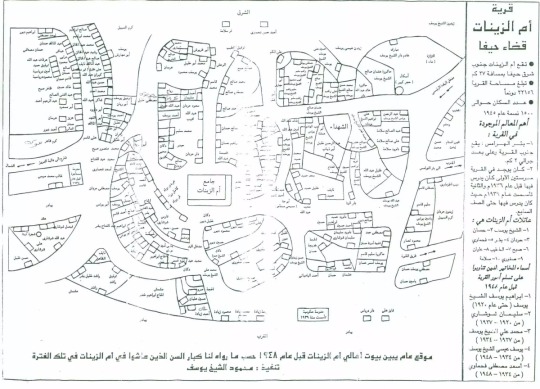
View On WordPress
0 notes